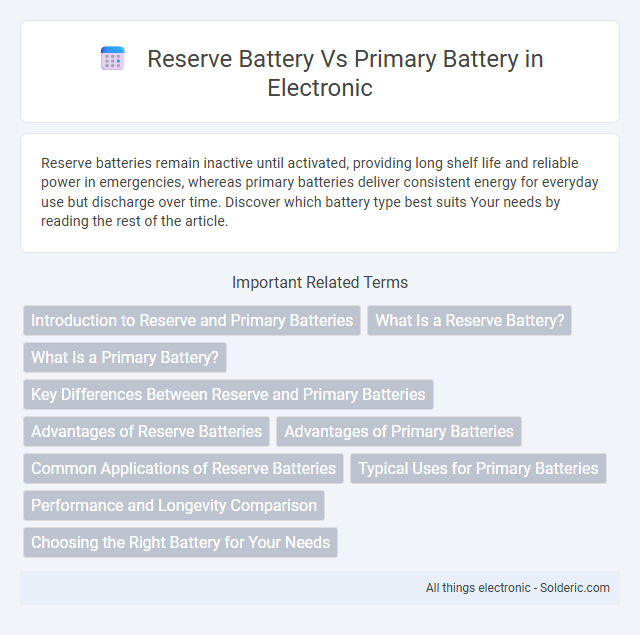Reserve batteries remain inactive until activated, providing long shelf life and reliable power in emergencies, whereas primary batteries deliver consistent energy for everyday use but discharge over time. Discover which battery type best suits Your needs by reading the rest of the article.
Comparison Table
| Feature | Reserve Battery | Primary Battery |
|---|---|---|
| Definition | Battery activated only when needed by adding electrolyte. | Battery ready to use immediately after manufacturing. |
| Activation | Requires manual activation (electrolyte addition). | No activation needed; stored electrolyte inside. |
| Shelf Life | Long shelf life, often over 10 years. | Moderate shelf life, typically 3-5 years. |
| Usage | Used in emergency, military, or backup power applications. | Everyday consumer electronics and devices. |
| Cost | Higher initial cost due to design and longevity. | Lower cost, mass-produced for wide use. |
| Energy Density | Generally higher energy density available on activation. | Moderate energy density with immediate availability. |
| Maintenance | Requires condition checks and proper electrolyte storage. | Minimal maintenance, often disposable. |
| Examples | Air-activated Zn-MnO2 batteries, thermal batteries. | Alkaline batteries, zinc-carbon batteries. |
Introduction to Reserve and Primary Batteries
Reserve batteries remain inactive until activated, offering extended shelf life and reliable power in emergencies, while primary batteries provide immediate energy with a limited lifespan once activated. Your choice depends on application needs: reserve batteries suit long-term storage devices like military gear, whereas primary batteries fit everyday electronics requiring instant use. Understanding these differences enhances battery efficiency and operational reliability in critical situations.
What Is a Reserve Battery?
A reserve battery is designed to remain inactive and fully charged until activated for use, ensuring maximum longevity and reliability in emergency or critical applications. Unlike primary batteries, which provide continuous power from the moment of manufacturing, reserve batteries separate the reactive components until needed, preventing self-discharge and chemical degradation. You can rely on reserve batteries in situations where long shelf life and immediate power delivery upon activation are essential.
What Is a Primary Battery?
A primary battery is a single-use electrochemical cell designed for one-time discharge and non-rechargeable operation, commonly used in devices like remote controls and flashlights. It stores chemical energy which converts directly into electrical energy until depleted, making it ideal for applications needing reliable, long-term power without maintenance. Understanding the differences between primary and reserve batteries helps you choose the right power source for your specific energy demands.
Key Differences Between Reserve and Primary Batteries
Reserve batteries remain inactive until exposed to an external stimulus such as water or air, making them ideal for long-term storage and emergency use, whereas primary batteries are active upon manufacture and provide immediate power. Reserve batteries typically offer extended shelf life and superior reliability in harsh conditions but often require activation steps before use, unlike primary batteries which are ready for immediate consumption. The design of reserve batteries prioritizes long-term preservation and delayed activation, while primary batteries focus on consistent, immediate discharge for various everyday applications.
Advantages of Reserve Batteries
Reserve batteries offer extended shelf life and enhanced safety by remaining inactive until needed, reducing the risk of leakage or premature failure. They are ideal for emergency or military applications where long-term reliability and immediate power activation are critical. Your choice of a reserve battery ensures dependable performance in harsh or unpredictable environments.
Advantages of Primary Batteries
Primary batteries offer long shelf life and immediate usability without the need for activation, making them ideal for emergency devices and low-drain applications. Their simple construction results in lower manufacturing costs and widespread availability, enhancing convenience for everyday consumer electronics. Unlike reserve batteries, primary batteries do not require additional activation mechanisms, ensuring reliability and reduced maintenance requirements.
Common Applications of Reserve Batteries
Reserve batteries are commonly used in military equipment, emergency backup systems, and aerospace applications due to their long shelf life and activation only when needed. These batteries remain inert until exposed to a triggering mechanism, making them ideal for critical uses such as missiles, sea mines, and fire suppression systems. Your choice of reserve batteries ensures reliability in environments where power sources must remain inactive until emergency activation.
Typical Uses for Primary Batteries
Primary batteries are commonly used in devices that require low to moderate energy consumption over long periods, such as remote controls, flashlights, and smoke detectors. These batteries are ideal for disposable, single-use applications where recharging is not practical or necessary. Your choice of a primary battery ensures reliable power for everyday electronics with minimal maintenance.
Performance and Longevity Comparison
Reserve batteries exhibit longer shelf life and superior performance under extreme conditions compared to primary batteries due to their inert electrolyte activation only upon use. Primary batteries provide consistent performance for everyday applications but suffer from self-discharge and reduced longevity when stored for extended periods. The key advantage of reserve batteries lies in their ability to deliver reliable power in critical situations where extended storage and instant activation are essential.
Choosing the Right Battery for Your Needs
Choosing the right battery depends on application requirements such as shelf life, activation method, and discharge characteristics. Reserve batteries remain inactive until needed, offering extended storage life and reliability in critical uses like military or emergency equipment, while primary batteries provide immediate power with shorter shelf life suitable for everyday consumer electronics. Considering factors like energy density, activation delay, and operational environment ensures optimal battery selection for performance and longevity.
Reserve battery vs Primary battery Infographic

 solderic.com
solderic.com